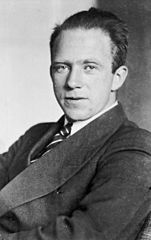
Heisenberg's uncertainty principle
The world we live in appears to be definite. Something exists or it doesn't. An object is either here or there. You are either alive or dead. Quantum physics, however, is famously counterintuitive in this sense. The quantum world is fuzzy, where the definite is replaced with probabilities; a particle can be here, or there, or a mixture of the two, and we can only predict its location with probabilities given by something called the wave function. (You can read more about the the role of probabilities and the wave function in A ridiculously short introduction to some very basic quantum mechanics.)

Werner Heisenberg in 1933 (photo: German Federal Archive)
This quantum fuzziness lies behind one of the most famous principles of quantum physics: Heisenberg's uncertainty principle. In 1927 the German physicist, Werner Heisenberg, framed the principle in terms of measuring the position and momentum of a quantum particle, say of an electron. (The momentum of an object is its mass times its velocity.) The uncertainty principle states that you cannot know, with absolute certainty, both the position and momentum of an electron – the more accurately you measure one of these properties the less accurate your knowledge of the other.
If we write the uncertainty in a particle's position as $\delta x$, and the uncertainty in a particle's momentum as $\delta \rho$, then the uncertainty of these two properties is connected in the following way: $$ \delta x \times \delta \rho \geq \frac{\hbar}{2} $$ where $\hbar$ is the Planck's constant (a kind of order of magnitude of the quantum world) divided by $2\pi$.
This is the most common mathematical expression of Heisenberg's uncertainty principle, that the product of these uncertainties has a minimum value. But the principle extends to other pairs of particles (called complementary variables), such as length of time and energy, whose connection is expressed in similar inequalities.
A misleading thought experiment
Heisenberg himself tried to understand this principle physically using the following thought experiment. Suppose you wanted to locate the position of an electron. To do this you would use a microscope which bounces photons of light of an object in order to observe it. The accuracy of a microscope is limited by the wavelength of the light used – the shorter the wavelength the more accurate your observations. Heisenberg suggested using a gamma-ray microscope as gamma-rays are a type of light with a very short wavelength.
But the tradeoff is that light waves with a shorter wavelength have a higher frequency, and the photons have correspondingly higher energy. (This is because for waves, $v=\lambda f$ where $v$ is the speed of the wave, $\lambda$ is the wavelength and $f$ is the frequency. The speed of light is fixed at $c\approx 3\times 10^8 ms^{-1}$ so as the wavelength decreases the frequency must increase. And the energy, $E$, of a photon is given by$E=hf$.) Heisenberg reasoned you could very accurately measure an electron's position with a gamma-ray microscope, but to do so you have to bounce at least one gamma-ray photon off the electron. But the energy of gamma-ray photons is so high, the collision would affect the motion, and hence the momentum, of the electron. So a gamma-ray microscope would give you a highly accurate measurement of an electron's position, but the disturbance would create a less accurate measurement of the momentum.
Heisenberg's thought experiment might seem clear but is misleading as it could suggest that the uncertainty principle is a result only of the disturbance caused by observation (this is another phenomenon, known as the observer effect). "Heisenberg's uncertainty principle is often phrased in terms of measurement, but really you should think [in terms of] the electron itself," says Ben Allanach, professor of theoretical physics at the University of Cambridge. The uncertainty captured in the principle is inherent in the quantum world, whether it is observed or not.
A clearer view of uncertainty
Although Heisenberg's uncertainty principle might seem a confusing idea, it has a simple clarity when you describe the situation mathematically. A quantum system, such as the electron Heisenberg was thinking of, can be described mathematically using Schrödinger's equation. The state of that system at a particular time is given by the wave function, a solution to this equation, which can only give probabilities for the values of particular properties of the system. The fuzziness inherent in quantum physics means that it is impossible to predict the position of an electron when we measure it. "What you think of as an electron is fuzzy in space," says Allanach. "When you measure an electron you measure it to be in a precise position. But if you prepared a million identical electrons and measured them they'd be spread around a little bit." The spread of these measurements would reflect the probabilities given by the wavefunction. The same goes for any other thing you might want to measure about the particle, for example its momentum: all you can do is work out the probability that the momentum takes each of several possible values.
To work out from the wave function what those possible values of position and momentum are, you need mathematical objects called operators. There are many different operators, one for position, one for momentum, one for any property you are able to observe in a system. Usually the operator, such as the position operator, acts on a wave function to return a description of the possible locations of an electron and the probabilities you’d find the electron in each location if you were to measure it. But for each operator, there are particular wave functions called eigenstates of that operator, that return a single location, indicating that for that particular eigenstate the operator will return a single location at which the electron will be found with 100% certainty.
The same is true for other operators. There are eigenstates of the momentum operator, that will have a particular value for momentum, with 100% certainty. But it is a mathematical fact that a system can never be in an eigenstate of both the position and momentum operators simultaneously. Just as 3+2 will never make 27, so the mathematical operators corresponding to position and momentum don’t behave in a way that would allow them to have coinciding eigenstates. (For those familiar with some of the technicalities, the eigenstates cannot be the same because the operators don't commute.)

There's a limit to how much you can simultaneously squeeze the quantum fuzziness of an electron's position and momentum.
The same goes for other complementary pairs of operators, such as those for time and energy, or for the quantum spin of a particle in different perpendicular directions. Mathematically, 100% certainty about the values of these pairs of properties just isn’t possible, regardless of measuring the quantum system. "That quantum fuzziness is like a physical limitation to the amount that you can specify where any electrons are going to be before you measure them," says Allanach. "It's really to do with the electron, with the particles themselves, rather than just measurement." You can't squeeze the quantum fuzziness of both the position and momentum properties of a particle below a certain limit simultaneously, regardless of if you measure these properties.
Since Heisenberg first described the uncertainty principle in terms of position and momentum, similar uncertainty principles have been described for other complementary pairs. All of these lead to fascinating and surprising results in quantum physics, such as the bubbling of virtual particles in a vacuum. And don't worry if you still find these ideas counterintuitive, you are in very good company: Einstein himself was appalled by Heisenberg's uncertainty principle and the "cloudy fitfulness" provided by this view of reality. Physicists today have got used to these ideas and are making good use of this fuzziness.
About the article

Ben Allanach is a Professor in Theoretical Physics at the Department of Theoretical Physics and Applied Mathematics at the University of Cambridge. His research focuses on discriminating different models of particle physics using LHC data. He worked at CERN as a research fellow and continues to visit frequently.
Rachel Thomas is Editor of Plus.
This article is part of our Who's watching? The physics of observers project, run in collaboration with FQXi. Click here to see more articles about the limits of observation.